
The approximate position of ‘C’ Company, 2/18 London Regiment on 1-2 May 1918. Detail from a sketch map within the unit war diary. (Reference: WO 95/4670)
Frederick William Beament, my great grandmother’s younger brother, fought in the British Army during the First World War. He died on 2 May 1918, aged just 21.
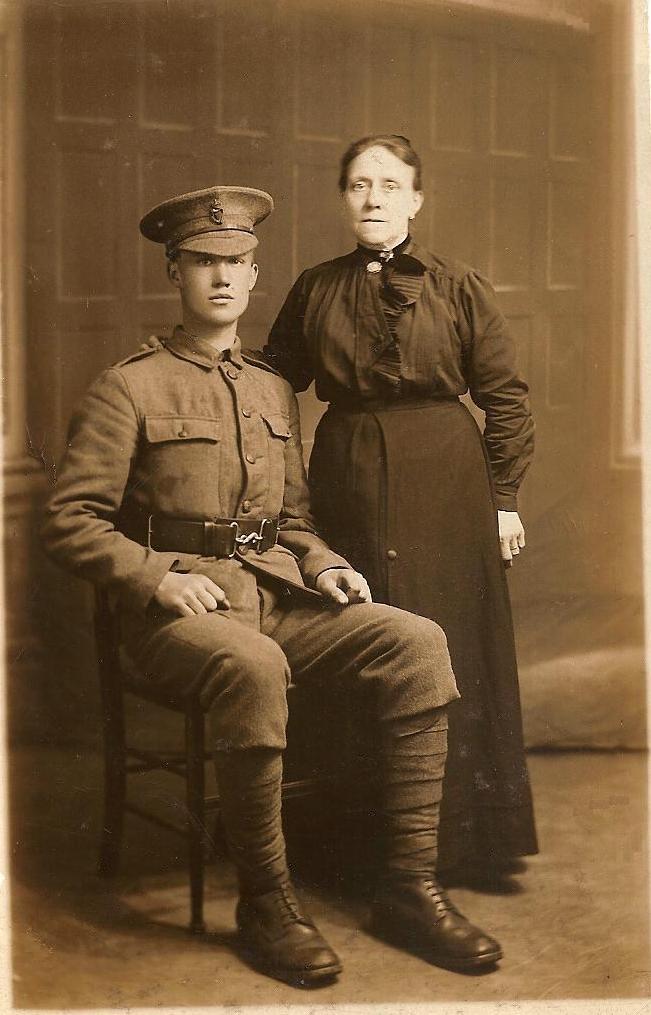
Frederick in his army uniform, with his mother, Elizabeth. (Private collection)
In researching this blog post for our My Tommy’s War series, I had two major advantages. Firstly, I already knew some information about Frederick. Much of this knowledge had been passed down through successive generations of the family and other details had been researched by relatives on my father’s side more recently. [ref] 1. Thank you especially to my Dad for his help. [/ref] Secondly, I already knew about some sources at The National Archives that would be likely to help me find out more about Frederick, because advising people about records held here is part of my job.
Who was Frederick?
Frederick was born on 23 June 1896 in Holborn, in central London, the youngest of at least eight children. His father, George, died when he was very young and his widowed mother, Elizabeth, brought up the younger children alone. Like his father and many of his siblings, Frederick started work in the printing industry when he left school. In the 1911 census, when he was 14 years old, his occupation is stated as ‘reading boy’ for a printing firm. [ref] 2. RG 14/1212 schedule number 125. [/ref]
To find out about Frederick’s army service, I started with his entry in the casualty database on the Commonwealth War Graves Commission’s website. As well as his age and the date that he died, this told me the following:
- His rank: Rifleman (equivalent to Private)
- His regiment and battalion: 2/18 London Regiment (also known as the London Irish Rifles). Within this unit, he was part of ‘C’ Company
- His service number: 590289
- The location of his grave: plot N.47 in Jerusalem War Cemetery. This is also a clue that he fought in the Middle East, specifically in Palestine
My next step was to check whether I could find a service record for Frederick. Although digital images of the surviving First World War service records for ordinary soldiers are searchable on the Ancestry.co.uk website, about two thirds of the original records were destroyed during Second World War bombing, so I knew that my chances of success were not high. Despite trying all the usual techniques (including searching just by surname and service number, misspelling his surname and using wild cards), I could not locate Frederick’s service record.
I did find Frederick’s campaign medal index card [ref] 3. WO 372/2/301642. [/ref] but the only new information that I gleaned from this was that he was awarded the standard Victory Medal and the British War Medal. The code number TP 18/101B given on the card relates to the original medal roll for Frederick’s unit [ref] 4. WO 329/1937. Frederick Beament’s entry is on page 37. [/ref] but, as I already knew Frederick’s full battalion number (which would be the only information on the roll that is not also written on the medal index card) there was no need for me to check the roll.
The unit war diary
As I wanted to find out what Frederick’s unit was doing when he died, I decided to look at its war diary for May 1918. [ref] 5. WO 95/4670. [/ref] I found this by searching for “2/18” AND London AND “WO 95” in Discovery, our catalogue. [ref] 6. As I knew from our research guide that WO 95 is The National Archives series number for First World War Army unit war diaries, I included it to make my search more precise. [/ref] This record has not been digitised, so I worked my way through the original box until I found the correct unit and then the correct month. I took advantage of the fact that we allow researchers to use their own cameras to photograph documents in our reading rooms [ref] 7. See our policy on self-service photography of records[/ref] and took photos of the relevant pages so that I could read them more thoroughly later.
As well as brief ‘diary-style’ entries, the war diary includes appendices in the form of handwritten or typescript reports giving additional information. Although it mentions very few individual men (almost all officers) by name, it includes quite a lot of detail about what the battalion was doing on each day. On 1 and 2 May 1918, 2/18 London Regiment was fighting in the area of Tell Buleibil [ref] 8. The transliteration of Arabic place names varies considerably. Tell Buleibil is spelt several different ways in the war diary and other sources; a more modern transliteration is Tall Bulaybil. [/ref] and Shunet Nimrin, about half-way between the River Jordan and Amman. Formerly known in English as Transjordan, this area is now part of the Kingdom of Jordan.
The diary records that ‘C’ Company was largely kept in reserve on 2 May, having suffered heavy losses the previous day. I cannot be certain, but it may be that Frederick was wounded on 1 May and died of his injuries the following day.
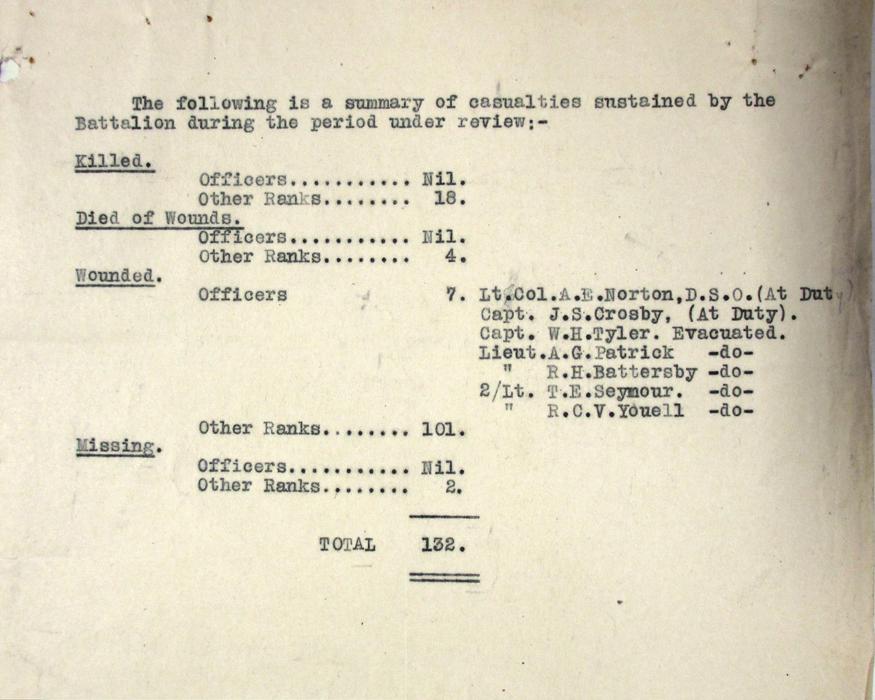
This summary of casualties forms part of Appendix B to 2/18 London Regiment’s war diary for May 1918. (Reference: WO 95/4670)
The Second Action of Es Salt, 30 April – 4 May 1918
As I did not know very much about events in the Middle East during the First World War, I turned to some published sources in our reference library to help me understand the context of the information that I had found in the war diary. I found the relevant volume of the official History of the Great War [ref] 9. Cyril Falls, Military operations: Egypt and Palestine from June 1917 to the end of the war (London, 1939), comprising two volumes and a case of maps. Volume 1, chapter 17, ‘The Second Raid into Trans-Jordan’, pp 364-394, covers the relevant operation. [/ref] especially helpful.
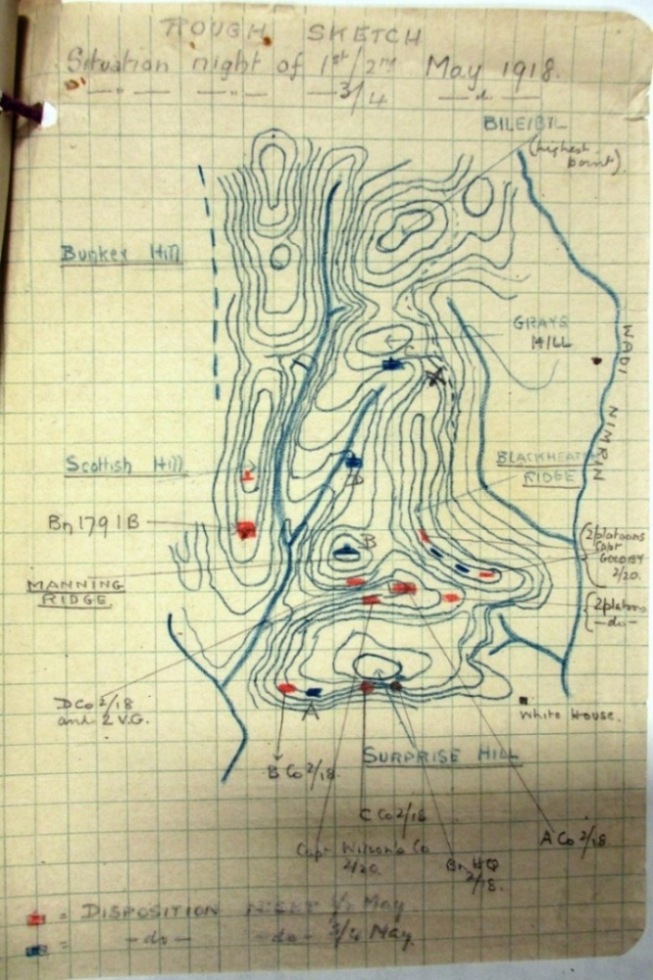
The sketch map also forms part of Appendix B to 2/18 London Regiment’s war diary for May 1918. (Reference: WO 95/4670)
I learned that the activities described in the war diary were part of an wider operation known as the Second Action of Es Salt, or the Second Transjordan Raid, which took place between 30 April and 4 May 1918. [ref] 10. If you are interested in reading more about the Second Action of Es Salt, there is a very detailed Wikipedia article on the subject, with full referencing to a variety of published sources. [/ref] A combined force of British, Australian, New Zealand and Indian troops attacked territory on the eastern side of the River Jordan that had been in the hands of German and Ottoman (or Turkish) forces. Initially, the allied forces made significant territorial gains, but by 4 May they had been forced to retreat back across the River Jordan to Palestine. Although the Germans and Ottomans won this encounter, they probably lost more men than the British and their allies did.
Looking for maps
As I have a particular interest in our map collections. I also wanted to find out what maps we hold showing the area where Frederick died. Finding First World War military maps among our records is not always easy and can be time-consuming, but I knew that there were three main places to look for relevant maps among our records:
- Within the war diaries themselves (series WO 95)
- In a set of maps relating to the Palestine Campaign (series WO 303)
- In a general set of First World War maps (series WO 153)
I was lucky and found something in all three places.
The map within the war diary is a detailed sketch showing where troops were stationed near Tell Buleibil. [ref] 11. WO 95/4670. The sketch map is part of Appendix B within the war diary for 2/18 London Regiment, May 1918. [/ref]
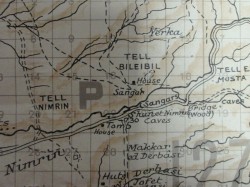
Detail from the printed 1:63,360-scale map. (Reference: WO 303/314)
War diaries often refer to specific named or numbered printed map sheets, and sometimes they even mention precise grid references. In this instance, the diary refers to a map at the scale of 1:63,360 (1 inch to 1 mile) with the title ‘Composite Map East of Jordan (Es-Salt)’ several times, but without specifying grid references. I found a copy of this map in the WO 303. [ref] 12. WO 303/314. This is actually a slightly later edition than the one specified in the diary but it was good enough for my purposes. [/ref] In the same series, I also found a larger-scale (1:40,000) map of the area [ref] 13. WO 303/355. [/ref] but there is little difference in the amount of detail shown.
In the WO 153 series, I found a much smaller-scale (1:250,000) map showing the general disposition of forces of different nationalities throughout Palestine and surrounding areas. [ref] 14. WO 153/1040 item 9. [/ref] This is a fascinating map to look at but would probably be more useful to military historians than to people researching an individual ancestor.
What next?
If you want to research a British soldier who died during the First World War, the following research guidance pages on our website are helpful places to start:
- Start Here: guidance for people new to using archives
- Deaths in the First and Second World Wars
- British Army soldiers after 1913
- First World War (an overview of sources)
- British Army operations in the First World War
- Military maps of the First World War
Relevant podcasts available on our website include Tracing battalions or regiments and The final whistle.
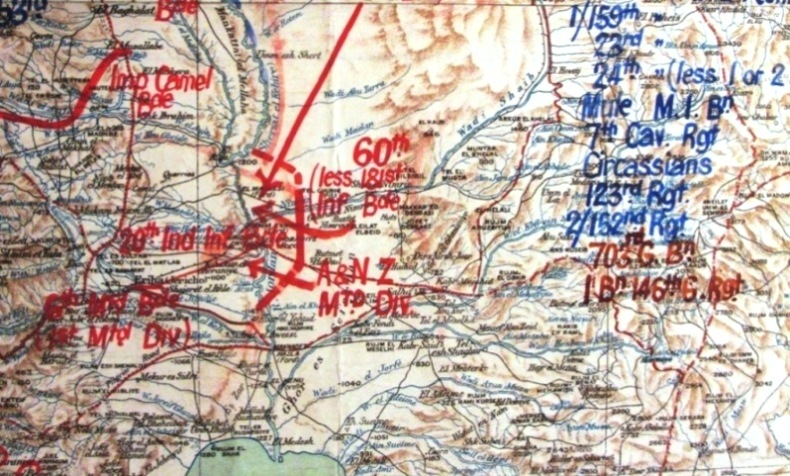
Detail from a much larger map showing the distribution of forces in the area. 60th Division included 2/18 London Regiment. (Reference: WO 153/1040 item 9)
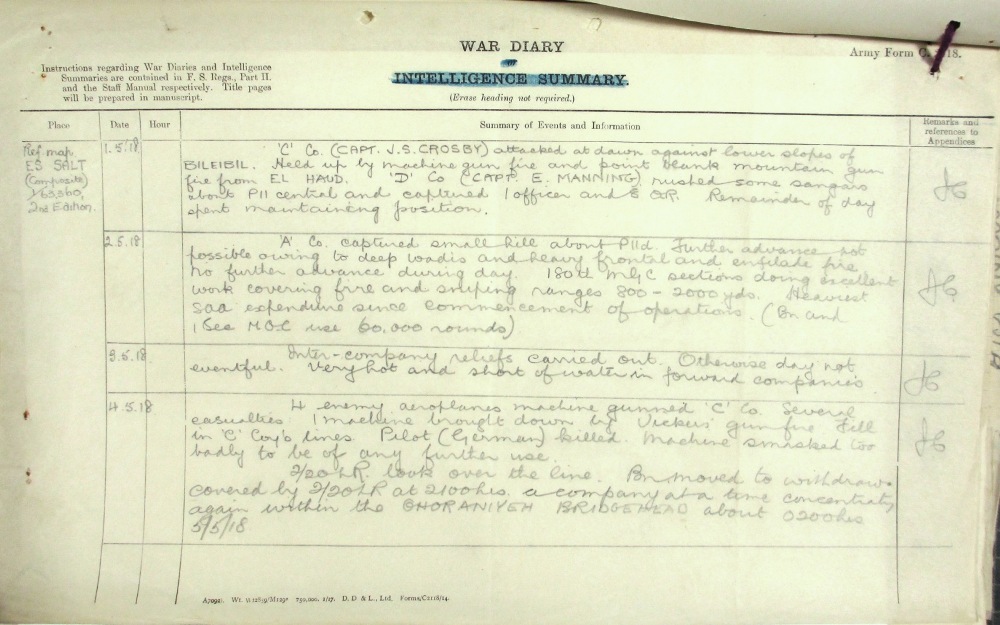
I’d say that it’s always worth checking the medal roll, even if it seems unlikely to tell you anything new. In the case of My Tommy it revealed an attachment to the Royal Engineers that wasn’t on the MIC. Also the London Regiment rolls are often very detailed (with more info than they were required to have). See for example this roll from 1st Londons and you’ll see it shows full posting history, with dates.
There are a couple more conclusions to be drawn (tentatively) from the information you already have too. Neither his CWCG entry, nor his entry in Soldiers Died in the Great War (which also shows he was born in and living at Holborn when he enlisted at Chelsea), mention a previous number. The series of six-figure numbers such as his were only issued in early 1917 in a complete renumbering of those serving in Territorial Force units such as the London Regiment. This suggests he was not called up until after the numbers were issued. If the medal roll does give dates for his overseeas service, it would help validate this conclusion.
Thank you, David. I must confess that the main reason that I haven’t looked at the medal roll (yet) is that I already had more than enough material for this post without it. I just chose the parts that interested me the most.
Incidentally, although neither the CWGC entry or the entry in Soldiers Died (which I included in the first draft the post but missed out of the final version to allow more space for the maps and the war diary) mentions another service number, the medal index card does! It was 1555. At some point I hope to get round to researching Frederick’s service earlier in the war.
Should have looked at that!
Paul Nixon’s useful blog on Army Service numbers suggests that your man was therefore (just) a pre-war Terrier, or joined in the first rush on the outbreak of war : 1486 joined on on 1st March 1914; 1861 joined on 10th August 1914. You could legitimately join the TF at 17 (maybe even 16), but wouldn’t be deployed overseas until 19. This would explain why he remained at home with 2/18th while 1/18th went to France in March 1915 (see http://www.1914-1918.net/london.htm) – early locations of 2/18th also shown there (no war diaries until ordered overseas).
Thank you again, David. That’s a useful point.
Thank you for this interesting post, I was with you all the way up to the War Diaries and then, because I live in Yorkshire you zoomed off and left me wistful.
I’ve only been to Kew once, in a week when we were in London anyway, I would love to go again, but it’s not to be, too far to go, too expensive and the OH would need a really good real ale pub nearby with some friends and an expense account (London beer prices!) to keep him happy whilst I was fossicking!
Thank you for your comment, Linda. I realise how lucky I am to work somewhere where I have ready access such interesting records. I hope you manage to visit us again one day!
It can be difficult for people who live a long way from our building in south-west London to do all of the research that they want to do. Many people manage to get round this to some extent by using our copying service (see http://www.nationalarchives.gov.uk/recordcopying/) or by commissioning paid research (see http://www.nationalarchives.gov.uk/records/paid_research.htm).
Andrew,
Could I make an important point for other researchers that the Army service records for Other Ranks (i.e non-officers) and who served after 1920 are still with the Ministry of Defence in Glasgow with no movement in their release, so ancestry (with their transcription/non-transcription errors and various versions) are not the only surviving records for the First World War.
Thank you for your comment, David. You are quite correct to say that records for men who continued to serve in the army for some time after the First World War are still held by the Ministry of Defence.
Of course, this does not help those, like me, who are researching an ancestor who was killed during the war.
I have had a similar problem with an ancestor, one of six men of the Cameronians (Royal Scottish Rifles) killed on Valentine’s Day 1918 near Arras.
Searching for W.H.Norris. Details from dog tag – Devon 315352 C E. He survived the lst W.W. and was probably a rifleman. No results at Kew. Water and fire damage to ‘his’ section. Can anyone help? Even just what his regiment did and where they went.
Thank you for your comment, Elizabeth.
I’m afraid that we can’t answer research questions through the blog, but there are a number of other ways you can contact us and one of our advisers will try to suggest something. Please see our website: http://www.nationalarchives.gov.uk/contact/ for your options. You can also look at our online research guidance: http://www.nationalarchives.gov.uk/records
As another commenter mentioned above, if ‘your’ man continued serving after the war and into the 1920s, the Ministry of Defence should hold some information.
Just came across this reference to Frederick William Beament. I have carried out all the steps that you have suggested as my Great uncle, Arthur Mitchell, service number 592908 died on the very same day, 2nd May 1918, as a member of the same regiment (2/18th) and is buried next to your relative in Jerusalem war cemetery (grave N.47). I searched on the CWGC site for soldiers who died on this day for this regiment and that gave me an indication of the numbers who died (9). I have also been through the unit war diary with those topographical maps! One thing I do not seem to be able to find out is which company he was in, but I suppose there is a good chance they new each other. One thing I have not been able to find is any reference to photographs of the regiment when in Palestine.
Thank you for your comment Tim.
I think I was just lucky that the CWGC entry told me which company Frederick was in. That information doesn’t come as standard.
Sometimes regimental museums have some photographs from as far back as the First World War but it’s quite possible that there aren’t any photographs of the regiment’s time in Palestine.
Good luck with your future research.
Thank you for the detailed explanation.
There is an NCO from the 2/19 LR that i want to find but i have only his last name.
Back to the 2/18th LR. There is a small museum in London and a regimental association,you might find some photographs there.
More photographs from the theater, can be found at the Matson collection in the Library of congress . https://www.loc.gov/resource/ppmsca.13709/?sp=1&st=list
you might want to search a site name or a term, inside the collection itself and not just this album.
IWM and AWM collections might offer images and paintings as well.
I do have a question regarding a Battle near Jerusalem, that i’m researching, an both Frederick and Arthur might have fought. in their letters or diaries, if they had any, did they mention the attack on Kh Adaseh?
Thank You,
Assaf
Dear Assaf,
Thank you for your comment.
To ask questions relating to research, please use our live chat or online form.
We hope you might also find our research guides helpful.
Hi
Frederick Beament was my grandfathers brother in law
I have some pictures letters etc
The beament family bible and some passed down memories
If you are interested then let me know
He was my great uncle
I have some of his effects including pictures of him with his friend my grandfather
Contact me if you want to extend his story